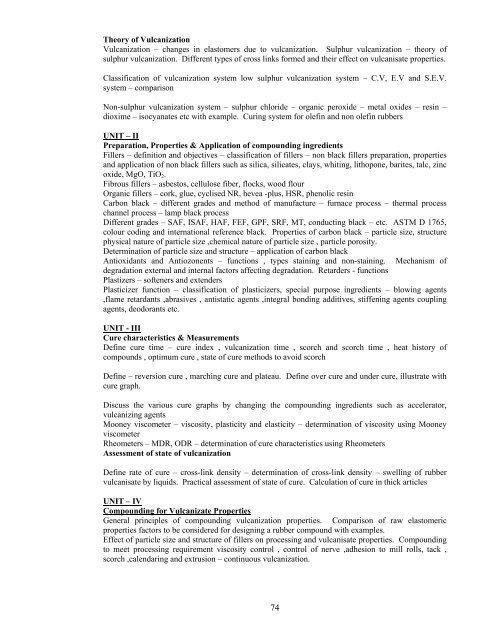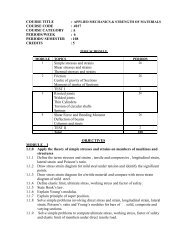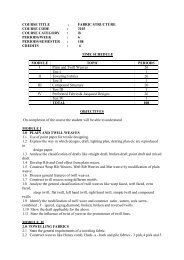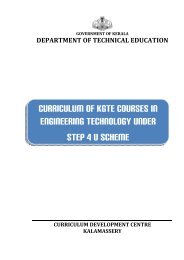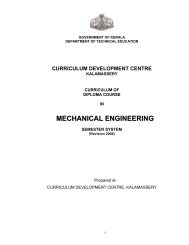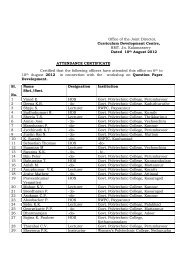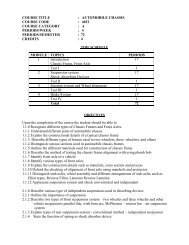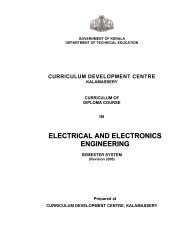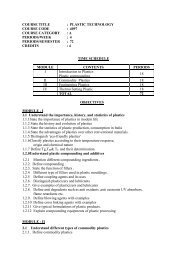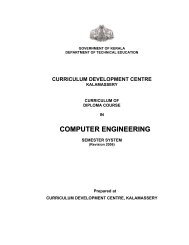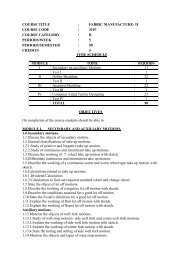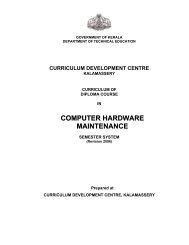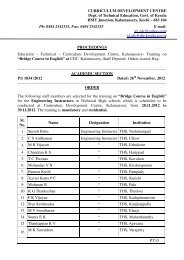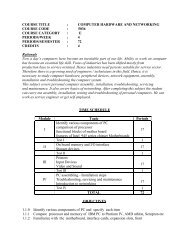23 - Curriculum Development Centre, Kalamassery
23 - Curriculum Development Centre, Kalamassery
23 - Curriculum Development Centre, Kalamassery
You also want an ePaper? Increase the reach of your titles
YUMPU automatically turns print PDFs into web optimized ePapers that Google loves.
Theory of VulcanizationVulcanization – changes in elastomers due to vulcanization. Sulphur vulcanization – theory ofsulphur vulcanization. Different types of cross links formed and their effect on vulcanisate properties.Classification of vulcanization system low sulphur vulcanization system – C.V, E.V and S.E.V.system – comparisonNon-sulphur vulcanization system – sulphur chloride – organic peroxide – metal oxides – resin –dioxime – isocyanates etc with example. Curing system for olefin and non olefin rubbersUNIT – IIPreparation, Properties & Application of compounding ingredientsFillers – definition and objectives – classification of fillers – non black fillers preparation, propertiesand application of non black fillers such as silica, silicates, clays, whiting, lithopone, barites, talc, zincoxide, MgO, TiO 2 .Fibrous fillers – asbestos, cellulose fiber, flocks, wood flourOrganic fillers – cork, glue, cyclised NR, hevea -plus, HSR, phenolic resinCarbon black – different grades and method of manufacture – furnace process – thermal processchannel process – lamp black processDifferent grades – SAF, ISAF, HAF, FEF, GPF, SRF, MT, conducting black – etc. ASTM D 1765,colour coding and international reference black. Properties of carbon black – particle size, structurephysical nature of particle size ,chemical nature of particle size , particle porosity.Determination of particle size and structure – application of carbon blackAntioxidants and Antiozonents – functions , types staining and non-staining. Mechanism ofdegradation external and internal factors affecting degradation. Retarders - functionsPlastizers – softeners and extendersPlasticizer function – classification of plasticizers, special purpose ingredients – blowing agents,flame retardants ,abrasives , antistatic agents ,integral bonding additives, stiffening agents couplingagents, deodorants etc.UNIT - IIICure characteristics & MeasurementsDefine cure time – cure index , vulcanization time , scorch and scorch time , heat history ofcompounds , optimum cure , state of cure methods to avoid scorchDefine – reversion cure , marching cure and plateau. Define over cure and under cure, illustrate withcure graph.Discuss the various cure graphs by changing the compounding ingredients such as accelerator,vulcanizing agentsMooney viscometer – viscosity, plasticity and elasticity – determination of viscosity using MooneyviscometerRheometers – MDR, ODR – determination of cure characteristics using RheometersAssessment of state of vulcanizationDefine rate of cure – cross-link density – determination of cross-link density – swelling of rubbervulcanisate by liquids. Practical assessment of state of cure. Calculation of cure in thick articlesUNIT – IVCompounding for Vulcanizate PropertiesGeneral principles of compounding vulcanization properties. Comparison of raw elastomericproperties factors to be considered for designing a rubber compound with examples.Effect of particle size and structure of fillers on processing and vulcanisate properties. Compoundingto meet processing requirement viscosity control , control of nerve ,adhesion to mill rolls, tack ,scorch ,calendaring and extrusion – continuous vulcanization.74


